Media | Articles
5 things you should know about the Hudson Hornet
If you think the replacement of bootleggers by professionals was the big tipping point in stock-car racing history, the latest documentary—embedded at the end of the article—from the Hagerty Drivers Foundation will likely teach you a few things. Today’s NASCAR would not exist if it were not for the drivers and teams who took a humble, straight-six-powered coupe racing in the 1950s. Here are five things you should know about the Hudson Hornet, the car that changed racing history.
The Hornet was never supposed to be a race car
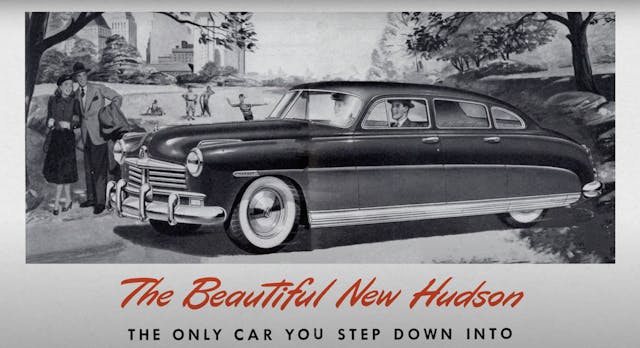
Hudson barely survived WWII. Because its manufacturing power was lower than that of General Motors or Ford, Hudson received fewer contracts, thus entering the 1940s a step or two behind the competition. Hudson was not going to roll over, though. It pushed to create something new and attractive, a vehicle that boasted safety, performance, and comfort. The Commodore was born in 1948 and primed the buying public for the coming Hornet.
It has a uni-body design
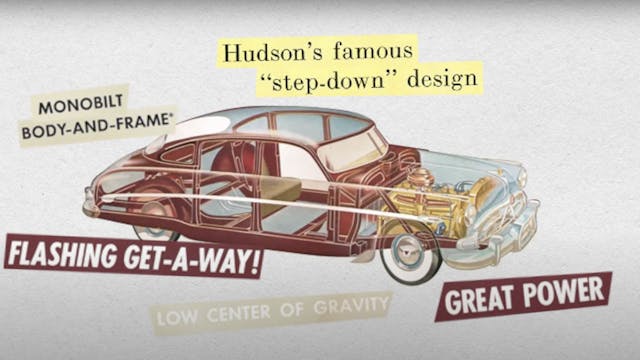
Hudson was not even close to producing the first unibody car, but its design and construction introduced what became the calling card for Hudsons of the era: the “step down.” Since the rocker panel was a structural part of the chassis, it was much more robust than on other cars, requiring engineers to either raise the floor to the height of the sill or lower the floor beneath the sill.
The Hornet was primed to win thanks to Bill France
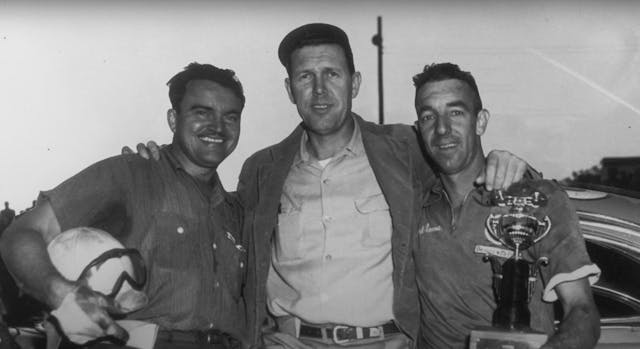
It was not until mid-1949 that driver and race promotor Bill France finally debuted a class called “strictly stock,” which showcased new cars that looked like those that people drove to work. France’s decision fed the idea that anyone could be a racing driver if they had “it” in them. Anyone not aspiring to race could at least cheer for a car that looked like the one in their driveway.
The chassis was good, but the engine was great
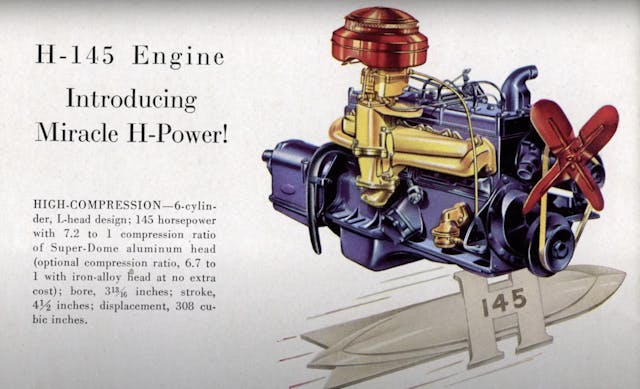
Hudson’s new-for-1951 inline-six displaced 308 cubic inches and was claimed to produce 145 horsepower. Cars in this era were just barely cracking triple-digit speeds—if at all—as pointed out by Richard Petty, who was then running a 97-hp Plymouth. As strange as it is to think of an inline-six as a competition engine, Hudson’s was the hot setup.
Marketplace
Buy and sell classics with confidence
The wheels were the weak point

Of all the teething problems that plagued these early stock cars, wheels were one of the most troublesome. The cornering forces generated in racing were so much higher than those produced by regular street driving that the wheels would liberate themselves from their axle or bend to the point of deforming. Hudson solved the problem by reinforcing the steel wheels with what amounted to a second wheel welded onto the first. You could even order the setup on production cars as a “severe duty” option.
***
The Hudson Hornet shaped the sport that would become stock-car racing. Because of its contribution, it will be documented forever in the Library of Congress thanks to the Hagerty Drivers Foundation. Check out the other 33 cars currently on the federally recognized National Historic Vehicle Register as well; there are even more fun stories to be found.
***
Check out the Hagerty Media homepage so you don’t miss a single story, or better yet, bookmark it. To get our best stories delivered right to your inbox, subscribe to our newsletters.
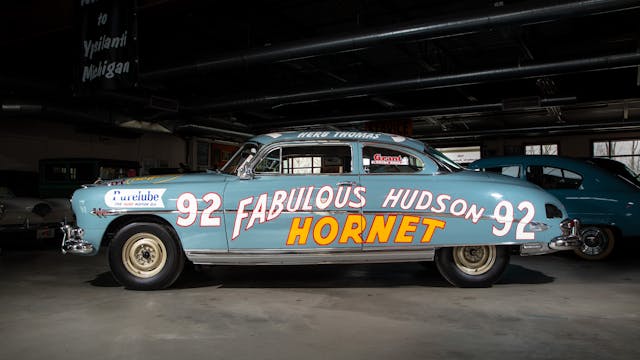






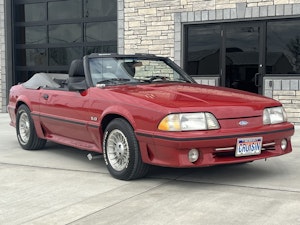







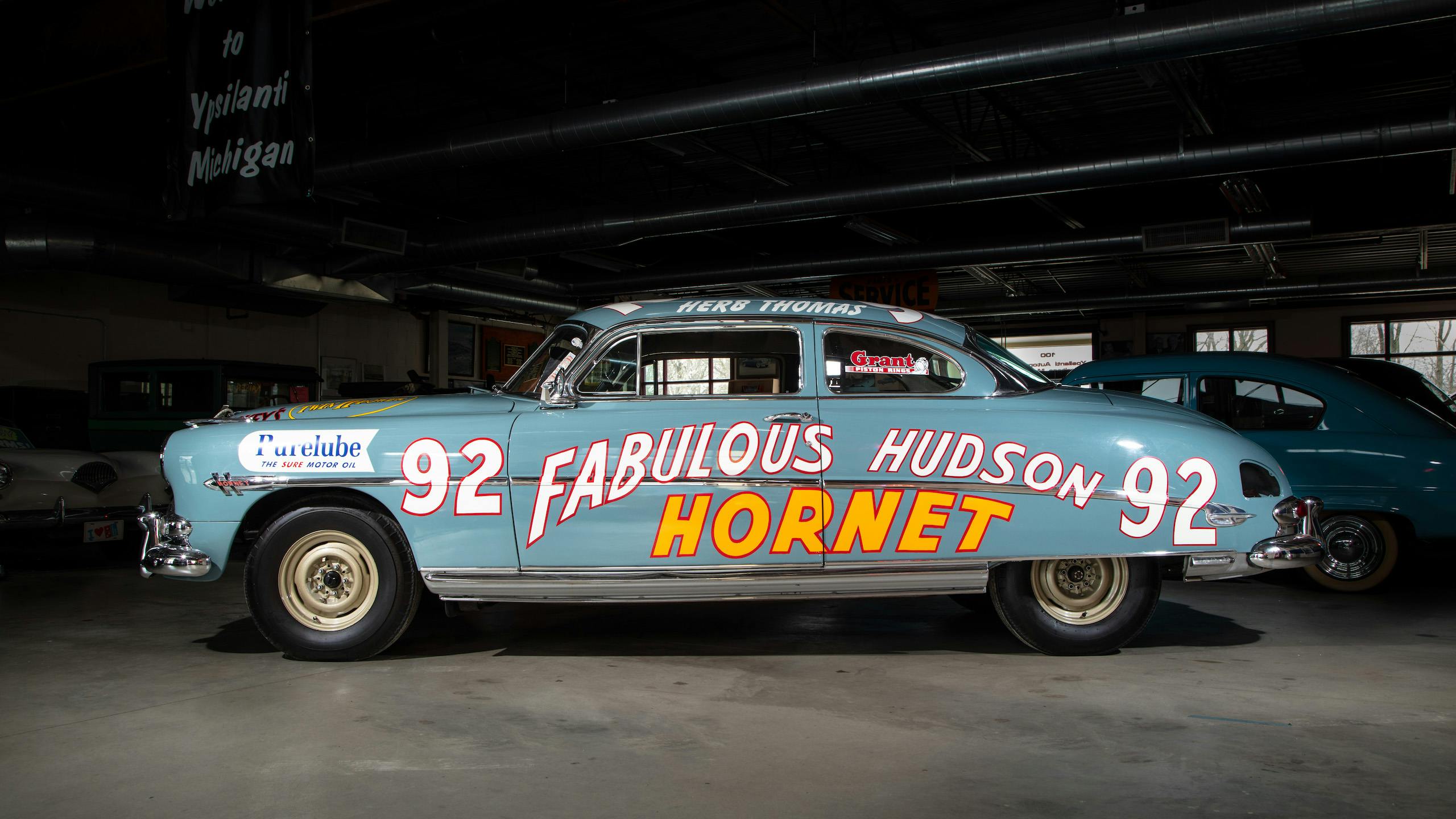
My wife was born on a small ranch in Eastern Idaho and her grandfather drove a Hudson. When they went to town for supplies or church, the kids were allowed to sit on his lap and steer on the country roads. After his death, the old Hornet was left to sit out in the weeds by the outbuildings, and became a kind of playhouse for she and her siblings. She can really not care less about any car in the world – except for that old Hudson, and she often reminisces about it and wonders whatever became of it. It’s the only car she’s ever loved, I think! When we saw the original CARS movie, I think she got all misty-eyed when the Hudson made its appearance.
Hudson Hornet article: “udson
Hudson barely survived WWIII. ”
Really? I missed that!
My uncle had one of these, worst lemon my family can remember in three generations.
Perhaps your Uncle was a whiner. My father owned one of these and it was the best car he ever had.
Mine too! He loved all of the Hudsons
Must have had a bad apple, they are a very good car and even now a days very dependable and durable.
My father was an auto mechanic before serving 4 years in WWII. On return to the states he saved up for a Hornet and he loved it. Traded it in for the sexy 57 DeSoto. Went from reliability to a lemon on steroids. Regretted it for 30 years.
Yep, I know a couple of guys still driving them today as well. Mostly on the weekends of course.
You should check your facts before publishing stories. The Hornet was introduced in 1951, not 1948.
The Hornet was manufactured from 1951 to 1957. Perhaps the reference to 1948 was to the step-down design which debuted in 1948 with the Commodore.
Also the Commodore name was not new to the ‘48 line up, it goes back to the late 30s or 40s
Thanks for the note Stuart. I did mix a few words there. I’ve updated the story to reflect the correct timeline.
You should re-read the article. “The Commodore paved the way…”
The article states the Commodore was introduced in 1948 priming the public for the “coming “ Hornet.
My uncle had one shipped over to Germany while serving in the Air Force in the 50s. He got a kick out of running the Autobahn and flashing his high beams for Mercedes to get out of the fast lane.
When I was a kid I worked with a great mechanic who was on the Hudson Racing team in the pit. The cars were actually raced by Lovelace Hudson in North Carolina. They were not sponsored by Hudson at all. The most amazing thing he told me Hudsons had cork clutches and there was a liquid additive that had to be periodically added through the bellhousing. More amazing than that was it took 16 hours to change a clutch in a Hornet. He said it came up through the floorboards and the interior had to be removed.
Hudsons were great cars with a high content of chromium in all the steel they used. 20 years ago I read in Automobile Quarterly that Cadillac had a directive not to have a Cadillac dealer too close to a Hudson dealer because Hudsons ran so quiet it embarrassed Cadillac. They made quality cars. I clearly remember Hudon running around the neighborhood as late as the early 70’s. I remember the aerial was on top of the roof and you could adjust it for better reception. I don’t know of any other car like that. It also was the first car that you stepped down. Every car today is step down. Step down lowers the center of gravity and it the turns at stock car races Hudsons didn’t have to slow down. It wasn’t as fast as the Oldsmobile Rocket 88 cars but could take a turn and make up the time there. I love Hudsons.
52 Buicks had same antenna/aerial roof adjustment
I fell into a step-down Hudson as a car-mad kid trying to get a closer look at the auto show at the Canadian National Exhibition. Really! Much embarrassment.
I never get tired of reading about the independents, especially Hudson. Thanks for sharing info about the Hornet that I never knew about. When the 1929 stock market crash took place to bring about The Depression, I think it was Patrick Foster’s book, The Last Independent, said that the top 3 car manufacturers in the U.S. were, in order of sales – G.M., Ford and ….Hudson. Don’t know if that is true or not. I am sure someone on this conversation knows.
Neighbors had one when I was a kid in the mid-1950s; a whole neighborhood of kids would pack into it for a beach trip. It seemed to run & drive just fine, though traffic back then was much less hectic. I think those Hudsons are where Smokey Yunick developed his famous creativity, including special factory parts.
Fantastic video! Watch it until the end. It is a true time machine of NASCAR RACING history.
Also, the expression on the young mans face when he was in the drivers seat of 92 car was priceless.
Truly an iconic and wonderful reminder of our history with the automobile.
Ah yes, me and my big sister sitting in the big back seat going for ice cream on Sundays. I would eat it until I got so sleepy then nap on that seat going home.
Great Hudson memories with Mom and Dad, brother and sis! All long gone but in my heart.
Lovely sentiment.
First car I went over 100 mph in. A green HH convertible with red Morrocan leather upholstery.
Cars definitely brought the profile of this car up in the public knowledge. I have always loved them but since the movies hearing little kids getting excited about seeing “Doc” is awesome.
That was in the 8 cylinder engines. The 6 cylinder engines introduceded in 1948 had full pressure oiling systems
That’s an interesting fun fact. Thanks for sharing Jim!
What led my Dad to not buy a step-down Hudson in the ’50s was the fact that they had NO oil pump, only crank dippers that ‘pressurized’ the engine bearings from impact to oil in the pan. Even at 14, that idea from the ’20s scared me!
Both Buick and Packard at that time had radio antennas in the same place above the windshield
That was in the 8 cylinder engines. The 6 cylinder engines introduceded in 1948 had full pressure oiling systems
Chevy used that until 54. Dippers or slingers.
Hudson’s were great cruise machines.. they road very well on long trips and when modern radials were replacing bias ply tires they really were smooth. I had mostly “stepdowns” (52-54s) except for a couple of Super Jets and one 1929 Essex rumble seat coupe. The bid Hudson’s had the widest seats in the industry….Caddies were smaller.
The version you must be refering to was the 8 cyl 254. The 232’s, 262’s and the Hornet 303 were all fully oil pressurized engines. Too bad your dad wasn’t aware. Great cars
Sadly, competition success did not turn into sales success. So Hudson merged with Nash to make American Motors, and soon only the Rambler remained.
How the once-mighty had fallen. Sad indeed.
My Dad took me to the Michigan state fair grounds in Detroit.
These cars dominated that long oval usually finishing 1 2 3.
The very first car I ever bought for $25.00 when I was 15 (1959) was a 1936 Hudson Terraplane coupe.
Hudson made some good looking cars back in the 30s but that Terraplane had to be the UGLIEST car in the world. Being young and dumb I took out on a paved backroad in Indiana to see what she’d do. I chickened out when I hit 105 mph and had gas pedal left. I think it weighed in at close to 2 tons and one of the rear brakes lines had been beaten flat with a hammer—3 brakes to stop a 2 ton car is not enough especially at 105 mph.
Shipping weight ’36 Terraplane coupe 2,810 lbs. Top speed mid 80s regardless a speedometer reading to 100 mph, such optimism standard in most cars. But three-wheel brakes would enhance the excitement.
Good buy. Born too late for $25 cars, tho’ you could still find ’49 Fords for 50 bucks in the 1972 Charlotte Observer.
A family ritual in the early 50s was to go to Langhorne and watch Marshal Teague tear up that dirt oval in his Hornet. Also did a” shine “run with one of my Fathers foremen in Nitro west Virginia, Yes! The machine loafed along those dirt roads at 80 mph.